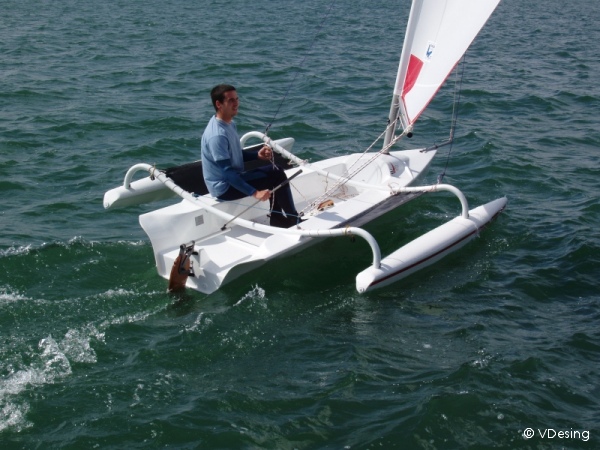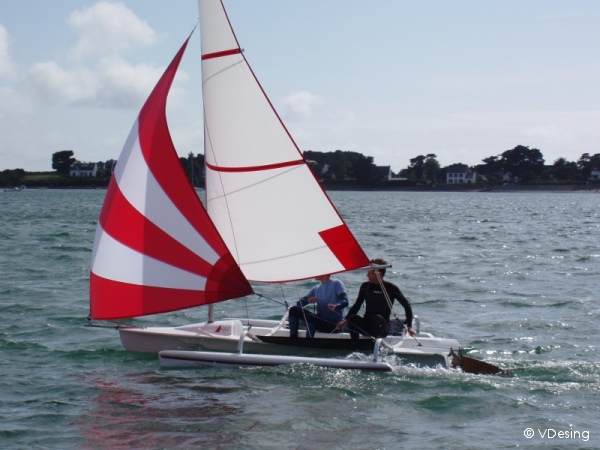question on trimaran handicap
Printed From: Yachts and Yachting Online
Category: Multihulls
Forum Name: Dinghy multihulls
Forum Discription: For those who prefer two (or more) hulls to one!
URL: http://www.yachtsandyachting.com/forum/forum_posts.asp?TID=3009
Printed Date: 14 Aug 25 at 7:16pm
Software Version: Web Wiz Forums 9.665y - http://www.webwizforums.com
Topic: question on trimaran handicap
Posted By: Pascal
Subject: question on trimaran handicap
Date Posted: 24 May 07 at 10:54am
|
Hi, Does anybody know anything about the catamaran handicap formula and whether it could be applied to a trimaran? Thanks, |
Replies:
Posted By: Scooby_simon
Date Posted: 24 May 07 at 11:24am
|
Pascal,
The SCHRS rule will deal with this; However, we do not have any factors to try and differentiate Cats from Tri's - however, I'd think we would get fairly close to an appropiate handicap and would welcome your feedback on the numbers generated. Go to http://www.schrs.com - www.schrs.com and download the calculation routine and have a play around. Please feel free to contact me for any guidance.
Cheers ------------- Wanna learn to Ski - PM me.. |
Posted By: Pascal
Date Posted: 24 May 07 at 11:59am
|
Thanks Simon. I've downloaded the calculation tool and tried with approximate measurements and this is what I got (I will have to go back to the manufacturer to get the detailed measurements).The minimum weight (WS) excludes crew weight, right? What do you think? How does that compare with the rating of a catamaran of similar size (4.18m)? Regards, Small Catamaran Handicap Rating System (SCHRS)
Further Details Measurements and Inputs
Rated Measurements
Intermediate Calculations
Corrections and Penalties
Power Factor
|
Posted By: mrzen
Date Posted: 24 May 07 at 12:14pm
|
One comment - by sitting on the windward float, wouldn't you be creating a similar righting force to a person on a trapeze? ------------- Hobie Tiger Hayling Ferry Sailing Club |
Posted By: Scooby_simon
Date Posted: 24 May 07 at 12:22pm
Yes, WS is excluding crew. Pascal do you really have an 8sqm Spi ? Does not sout too far out as it's small (but light). Do you have a link to a website with details. ------------- Wanna learn to Ski - PM me.. |
Posted By: Pascal
Date Posted: 24 May 07 at 12:22pm
|
You can't really sit on the windward float, just on the trampoline. I guess doing so would be equivalent to sitting on the trampoline next to the windward float on a catamaran. On a catamaran with a trapeze the righting force is higher as you're standing outside the boat. Regards, |
Posted By: Pascal
Date Posted: 24 May 07 at 12:30pm
|
Hi Simon, It's not actually a spi but a gennaker. Not sure if it make a difference. It's 7 sqm. The web site for the Astus 14.1 is http://www.exaqua.co.uk/astus141_overview.php - http://www.exaqua.co.uk/astus141.php Regards, |
Posted By: mrzen
Date Posted: 24 May 07 at 12:33pm
|
I think you are probably right pascal - here's another comment - (and I'm not an engineer to please feel free to correct me) the pivot point on a trimaran would be different to that of a cat and in fact would move accoridng to the forces on the boat. The pivot point on a cat is around the leeward float, but the pivot point on a trimaran would be similar to a monohull - around the main hull when upright, and then would move towards the leeward float as pressure on it increases... this would mean that using the cat handicap would disadvantage you in lighter winds as you will essentially be sailing a monohull with a bit of extra stability... tricky - what do others think...? ------------- Hobie Tiger Hayling Ferry Sailing Club |
Posted By: Scooby_simon
Date Posted: 24 May 07 at 1:06pm
|
We (The SCHRS group) do not have any meaningful data for Tri's As far as things go, some tri's fly 2 hulls when required. Also, The SCHRS rule takes into account trapezing crew as well as non-trapezing crew.
Generally you can build a stiffer tri and than cat as the mast is on a hull, and hot bouncing around on the front beam.
Also, looking at the website, it looks like that hull might plane. I cannot guarantee that SCHRS will come up with the right values (as stated we hve no real data on them) but it will be better than nothing at all ------------- Wanna learn to Ski - PM me.. |
Posted By: English Dave
Date Posted: 24 May 07 at 1:26pm
|
Well I am an engineer. But mostly I just bluff. This may be one of those occasions. Doesn't it depend on how the plane of the hulls is arranged? Most tris have their floats slightly higher than the centre hull so that only one is in the water at one time. But because the rig is on the centre hull any increase in wind strength will depress the leeward float rather than lifting the centre hull. So the drag increases with the wind You also have the problem of tacking. It's hard enough to get two long straight lines to turn a circle, let alone three. On cats you keep the weight on the "inside" hull as far as possible to help the outside one (which has further to go) skim across the water. At least that's the theory I work to. I sail under the auspices of the Irish Multihull Association. I have no idea what would happen if someone turned up anything other than a cat but in theory it's possible. Incidentally, how would foiling tris such a the TriWave and the Rave fit into the handicapping equation. And if lifting foils take such craft outside the remit of SCHRS then what about stabilising foils such as on F16 rudders? Over to you Scooby! ------------- English Dave http://www.ballyholme.com - Ballyholme Yacht Club (You'd think I'd be better at it by now) Hurricane 5.9 SX RS700 |
Posted By: Scooby_simon
Date Posted: 24 May 07 at 1:31pm
Hee hee, was wondering how long it would take someone to make that connection... SCHRS does not do "porper" foilers like the TriWave. For RM inducing devices such as opposing foils on rudders, I have a plan. It's is in theory, possible to calc the RM developed based on speed, foil angle and area. ------------- Wanna learn to Ski - PM me.. |
Posted By: Pascal
Date Posted: 24 May 07 at 2:02pm
|
This depends on the design of the tri. On a tri designed to fly the main hull, when it does so there's just one float in the water so it's pretty much like a cat. On a tri designed with a planing main hull, the crew would compensate the heeling by sitting out on the winward trampoline.
Tacking a tri is actually more similar to tacking a monohull because the centreboard is under the main hull, so the boat pivots around it. The floats are also much smaller than the main hull, so they just follow. Rgds, |
Posted By: mrzen
Date Posted: 24 May 07 at 2:06pm
If this is the case, wouldn't a tri be closer to a planing monohull than a cat? ------------- Hobie Tiger Hayling Ferry Sailing Club |
Posted By: Pascal
Date Posted: 24 May 07 at 2:15pm
| That's a difficult call... Maybe the tri could be compared to a skiff, with the floats replacing the trapeze? |
Posted By: mrzen
Date Posted: 24 May 07 at 2:25pm
|
that's what i'd say - the righting force exerted by the float would be large, like a couple of trapezers on the other side... i would also argue that as heeling force increases, drag should reduce, as the weight on the main hull would drop. As a result, I would have thought that planing would be achieved at a slower speed... Once planing, a skiff should then be able to achieve a higher speed as it would have less drag (as there is no stabilising float, just trapezeing sailors), however, you have to be a much better sailor to achieve a similar result... interesting... ------------- Hobie Tiger Hayling Ferry Sailing Club |
Posted By: Pascal
Date Posted: 01 Jul 07 at 1:53pm
|
First pictures from the sea trials:
I'll be bringing back the boat to Datchet in September. See you on the water! Pascal |


